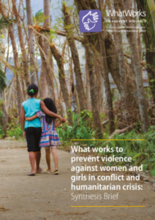Violence against women and girls (VAWG) is an important human rights concern and a pervasive issue affecting women and girls during times of conflict and humanitarian crisis. In 2016, the What Works to Prevent VAWG programme (hereafter What Works) published an evidence brief summarising the existing evidence base on VAWG in these settings. While the brief demonstrated that there is very limited evidence on what works to prevent and respond to VAWG in conflict and humanitarian settings, it did highlight key areas of learning and specify what information gaps remain.
Since the publication of the What Works evidence brief in 2016, researchers and practitioners have continued to conduct research and expand the international community’s knowledge base around VAWG and the effectiveness of programmes that seek to prevent and respond to this violence. These efforts include new results from eight research studies conducted by members of the What Works consortium in various conflictaffected and humanitarian settings. This new brief synthesises the key results of these What Works studies as well as other key findings from contemporaneous research efforts published since 2015 (see Annex 1 for details on the search strategy utilised). It aims to provide an up-to-date resource for practitioners, policymakers and researchers on the state of evidence on VAWG in conflict and humanitarian settings.
The first section of the paper summarises new knowledge on the nature of VAWG in conflict and humanitarian settings, presenting the findings of research on the prevalence, forms and drivers of different forms of violence in these contexts. The second section reviews what is known about the effectiveness of interventions designed to tackle VAWG in conflict and humanitarian settings, looking at recent evidence on VAWG prevention and then on VAWG response. The final section summarises the conclusions and provides recommendations for future policy, programming and research.

